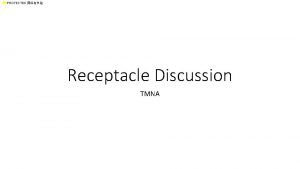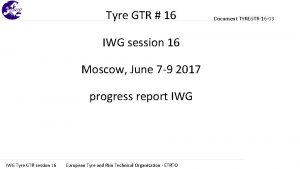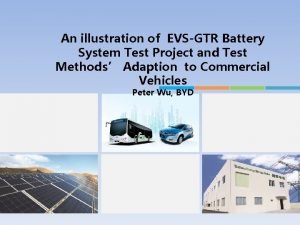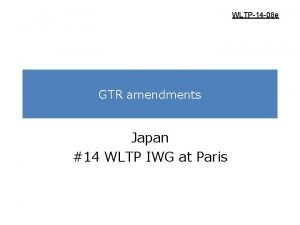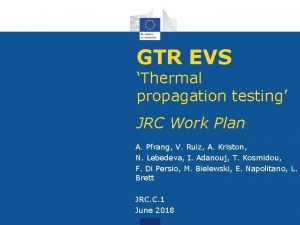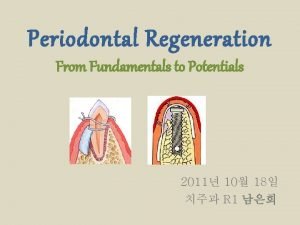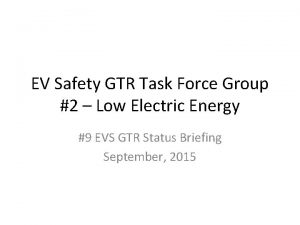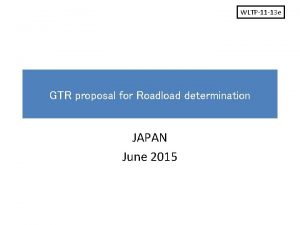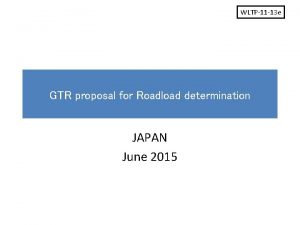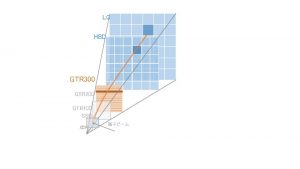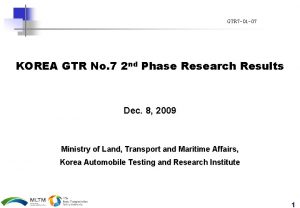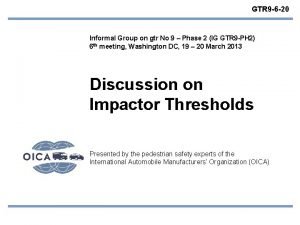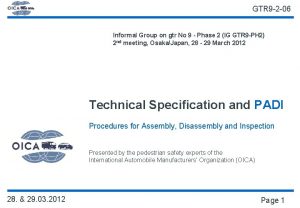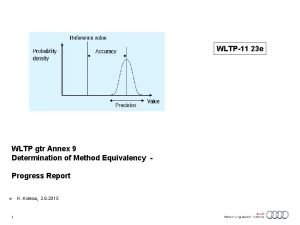WLTP10 24 e GTR proposal for Roadload determination










- Slides: 10

WLTP-10 -24 e GTR proposal for Roadload determination JAPAN April 2015

Background At the Annex 4 TF meeting in March, Japan proposed addition of GTR text describing manufacturer’s risk for roadload determination. The Annex 4 TF agreed that the request to put this topic on the IWG#10 agenda, asking if IWG agrees for this issue to be discussed and handled by Annex 4 TF or not. 2

Proposal Annex 4. 3. Measurement criteria 3. 1. Required overall measurement accuracy. Baseline standard method for roadload determination is a coasting down test performed according to paragraph 4. 3. of this Annex. The manufacturer is responsible for the accuracy of the roadload specification. The manufacturer shall ensure that the production vehicles conform with the roadload specification under the Baseline standard method, regardless of the methodology used to determine the roadload specification for type approval test. 3. 1. 1. Required overall measurement accuracy for each parameters. The required overall measurement accuracy shall be as follows: (a) Vehicle speed: ± 0. 5 km/h or ± 1 per cent, whichever is greater; …. . Justification To prevent the tolerances for roadload deamination from abuse and to clarify the manufacturer’s risk. 3

Roadload determination method 1. Measure roadload by testing. a) b) c) d) Coast down with anemometer Coast down without anemometer Torque meter Alternative method • Aerodynamics – Wind tunnel – Alternative method (e. g. CFD simulation) • Mechanical loss – Flat belt – Chassis dynamometer 2. Calculation based on actual measurement test described above. a) Combined approach b) Roadload interpolation under Roadload family rule c) Hybrid approach (combined default approach) 3. Default Roadload. Many possible ways to determined a roadload. 4

Tolerance/restriction/accuracy 35% 0. 015 m 2 5% 2% overall accuracy for each vehicle roadload is not clear. 5

Link of Interpolation among R/L family Roadload family A CO 2 family A: Diesel A AT H Highest cycle energy R/L: Test with WT+FB CO 2: Test CO 2 family C: Gasoline C AT H R/L: Level 1 Interpolation CO 2: Test R/L: Level 2 Interpolation CO 2: Interpolation Ind L R/L: Level 1 Interpolation CO 2: Test L R/L Determination for H R/L L H Coastdown Test for H R/L Determination for H L Ind by Road load interpolation under roadload family rule: +/- 5%±ε Allowable roadload range for WT+FB method Option B: Simulation Option A: Wind tunnel test +/- 0. 015 m 2±ε L Coastdown Test for L Lowest cycle energy R/L: Test with WT+FB CO 2: Test Option B: Wind. Tunnel+Flatbelt Option A: Coast. Down test Max. 35% cycle energy difference CO 2 family B: Diesel B AT L +/- 5%±ε ε is added because 5% is only required when its validation testing. 0 +/- 0. 015 m 2±ε H

Wind tunnel, Flatbelt, dynamometer, Simulation, etc. High Repeatability Less Testing burden/cost Technology development Coast down test (golden standard method) General standardized test method Level playing field Transparency 7

summary • There will be a chance for roadload to deviate from the real vehicle performance due to many possible ways to determine the roadload with tolerances. • Intentional abuse of tolerance has to be avoided. For example, wind tunnel may have the correction factor(s) which is outside of GTR restriction. • On the other hand, as wind tunnel or flatbelt, etc. can improve repeatability/accuracy and reduce testing burden significantly. • It should be allow to use these technique(i. e. wind tunnel etc. ), however the manufacturer should be responsible for the outcome of a mass production 8 car.

Compliance check system Public Emissions R/L determination Type approval R/L value CO 2 value COP ISC Never disclosed Never checked with production car. Roadload values have been used in type approval tests without checked with production car or disclosed to public, even though the values are very critical for the tests. 9

END 10

